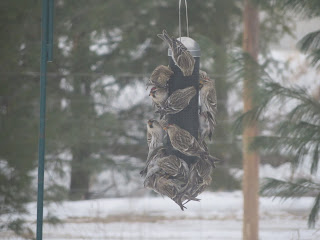

The 2021 season will follow a similar format to last
year. Many of the same crops (with a few
additions) and products should be available.
As well, we are on a waiting list for a pair of piglets; one farm has us
at the top of their waiting list.
Many of you inquired about our shiitake mushroom
project. Late last fall, we had a
consultation and tour with two of our mentors (Tom and Allaine from Elmtree
Farm). They indicated that it was not
uncommon for shiitakes to require two years before sprouting. If so, we just might have some this
year.
All details for the forthcoming season are updated soon
on the website. Seed prices have
increased, so I am obliged to increase the share price to $220.00 this year.
If you are interested in taking part in this year’s
CSA, please let me know soon. Our CSA sold out very quickly last year.
If this is your first time taking part in our CSA, please contact me. I prefer to meet by phone our new customers to ensure there is a match between your expectations and what I am able to provide.
Please do your best to be kind to one another and extra special thanks to everyone who is contributing in ways they never thought they would have to.
Bob and Julia
With the entire house yard enclosed, an area of unused property is now available. This portion of south facing slope has thin sandy soil. Our long term goal is to install solar panels here.
In the meantime, we are planting a wildflower meadow for our bees and other pollinators.
First, I mowed the wild grasses and cut the sumac saplings.
Next, I raked up the cuttings and ground thatch to expose the soil. The grass growth was quite thin owing to a fairly poor sand soil. I piled up the cuttings to reserve for later.
About 48 hours before our first snow fall, I sowed a seed mix of wild meadow pollinator flowers.
I'll do another sowing as soon as the ground starts to thaw next spring.
The final step will be to redistribute the raked up grass clippings to retain the organic material that this weak soil needs.
While cutting the grass and sumac, I came across a couple of tree seedlings.
They appear to be a variety of maple. I placed some protective fencing around them to prevent rodent damage, and to ensure that I did not accidentally step on the seedlings.
Another task were some improvements on the pig field.
First, I improved my gate - previously just a break in the fencing. Now I have what is referred to as a "poor man's gate". A small log is attached to the break in the fencing, and two loops - one at the bottom the other at the top (pictured) hold the fence closed to the end post of the fence. A little easier to open in the dark or when I am in a hurry.
I added some additional posts at the corners of each paddock, as the tension from the lines was too much for the portable stakes.
Another autumn task - long term cellar storage for carrots.
Any roots can be stored this way.
Place a layer of damp, clean sand in the bottom of a large barrel. Place a layer of carrots. Ensure that the carrots are not touching. Repeat the layering of sand and roots.
Keep the sand damp. Expect the carrots to try to sprout.
Some sources suggest using distilled water. Not certain why this is, though chlorine from municipal water or minerals from hard water might flavor the roots. This is just speculation on my part.
One other note, I suggest that you place the thickest carrots on the bottom of the barrel, as these will be less prone to drying out and lasting longer.
With the basic seasonal tasks finished, I got a head start on some property improvement work.
Previous photos will show the old heap of a fence that once surrounded the lower portion of the A-frame.
Last year, I dismantled half of it and had the ground graded.
In the space of a pair of afternoons, I removed most of the remaining fencing and cleaned out the dog house, or pig hutch, or whatever the little structure at the side used to be. It's next for the crowbar.
I wanted this done before next spring as we want the rest of the ground graded and a drainage swale dug as early as possible next year.
Our long term plan for this area is for keeping livestock - laying chickens, chick hatchery, and a 365 day dog house.
Now that the ground is getting cleared and levelled, I can get a better idea how to plan the layout and then the construction.
We'll be contacting you very soon about signing up for next years CSA.















